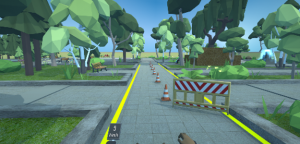Design, Development and Evaluation of a Power Wheelchair Driving Simulation in Virtual Reality
Aim and Research Question(s)
The aim of this thesis was to design and further develop an existing application, called WheelSim VR by LIFEtool, which is a virtual wheelchair simulator using current VR technology to enable people with disabilities to learn and train power wheelchair control. The main research question was: Does exercises in a traffic-free area in a VR power wheelchair simulation improve driving performance for a selected group of wheelchair trainers?
Background
The demographic change of the current society will increase the demand for powered mobility [1]. One of the biggest challenges is to ensure that power wheelchair users can adequately use a power wheelchair without causing accidents, consequently leading to injuries [2]. One way to increase the adequate use of power wheelchairs are technology-supported learning environments [3]. Virtual Reality (VR) is one possibility, which can provide a safe learning environment for power wheelchair users.
Methods
The power wheelchair driving simulation in VR was developed utilizing a user-centered design approach. Functional requirements and selected exercises in the traffic-free area were developed based on semi-structured expert interviews and a literature research. These requirements served as a basis for the development and usability testing of a working prototype. User tests with quantitative measurements, namely time and number of collisions, were conducted and evaluated. And finally, the System Usability Scale (SUS) and semi-structured expert interviews were held to gather qualitative data for the evaluation of the prototype.
Results and Discussion
A total of six exercises to learn basic mobility skills were filtered and implemented in the prototype. The test users reported a subjective improvement in driving performance. The measurement of quantitative parameters also showed an improvement in driving performance. Furthermore, all users were able to complete all tasks based on a given testing guideline without any issues. Thus, no major usability problems were detected. figure 1 Example of a developed exercise in the traffic-free area. Image courtesy of LifeTool Linz (WheelSim VR).
figure 1 Example of a developed exercise in the traffic-free area. Image courtesy of LifeTool Linz (WheelSim VR).
Conclusion
In general, the findings of this thesis suggest that the developed exercises in the traffic-free area improve driving performance of power wheelchair users.
- VR can be used as a safe environment for learning to drive a power wheelchair
- VR should be seen as an additional training method
- Future studies wheelchair drivers with special needs should be integrated
- Further developing of the technical requirements for an automated interpretation of the exercises is necessary
References
[1] Koontz et al., Biomed Res Int, 2015:1–2, 2015 [2] Carlsson and J. Lundälv, Traffic Inj Prev, 20:484–491, 2019 [3] Morère et al., Assistive Technology, 32:125–135, 2020
